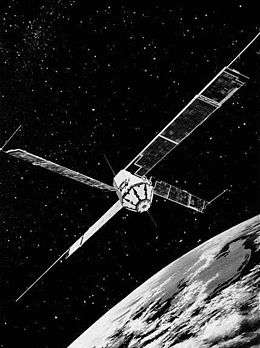Explorer 22
 Image of Explorer 22. | |
| Mission type | Earth science |
|---|---|
| Operator | NASA |
| COSPAR ID | 1964-064A[1] |
| SATCAT no. | 899 |
| Mission duration | 5 years and 4 months |
| Spacecraft properties | |
| Manufacturer | Applied Physics Laboratory |
| Launch mass | 52.6 kg (116 lb) |
| Start of mission | |
| Launch date | 10 October 1964, 03:07 UTC[2] |
| Rocket | Scout X-4 |
| Launch site | Vandenberg PALC-D[3] |
| End of mission | |
| Last contact | February 1970 |
| Orbital parameters | |
| Reference system | Geocentric |
| Regime | Low Earth |
| Eccentricity | 0.0130[1] |
| Perigee | 889 km (552 mi)[1] |
| Apogee | 1,081 km (672 mi)[1] |
| Inclination | 79.7°[1] |
| Period | 104.8 minutes[1] |
| Epoch | 10 October 1964[1] |
Explorer 22 (also called BE-2 or Beacon Explorer B) wan an American satellite launched as part of Explorers program of the NASA.
Explorer 22 was a small ionospheric research satellite instrumented with an electrostatic probe, a 20-, 40-, and 41-Hz radio beacon, a passive laser tracking reflector, and a Doppler navigation experiment. Its objective was to obtain worldwide observations of total electron content between the spacecraft and the earth.
The satellite was initially spin-stabilized, but it was despun after solar paddle erection. Subsequent stabilization oriented the satellite axis of symmetry with the local magnetic field by means of a strong bar magnet and damping rods. A three-axis magnetometer and sun sensors provided information on the satellite attitude and spin rate.[4]
There was no tape recorder aboard so that satellite performance data and electrostatic probe data could be observed only when the satellite was within range of a ground telemetry station. Continuous transmitters also operated at 162 MHz and 324 MHz to permit precise tracking by "Transit" tracking stations for navigation and geodetic studies. In August 1968, data acquisition from the satellite telemetry channels was discontinued. In July 1969, tracking and world map production were discontinued by GSFC, and world map production based on NORAD orbit elements was subsequently assumed by ESRO. The satellite failed in February 1970 and BE-C (65-032A) was turned on in order to partially replace use made of this satellite beacon experiment.[5]
See also
References
- 1 2 3 4 5 6 7 "BE-B". NSSDC Master Catalog. NASA Goddard Space Flight Center.

- ↑ "Launch Log". Jonathan's Space Page. Retrieved June 9, 2018.
- ↑ "Letter dated 22 December 1964 from the Permanent Representative of the United States of America addressed to the Secretary-General". UNOOSA. 30 December 1964. Retrieved June 9, 2018.
- ↑ Ludwig Combrinck, 2010. Sciences of Geodesy (Cap. 9). Springer-Verlag. Retrieved June 9, 2018.
- ↑ "Beacon". Encyclopedia Astronautica. Mark Wade. Retrieved June 9, 2018.
.png)